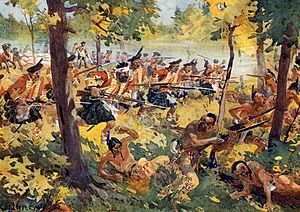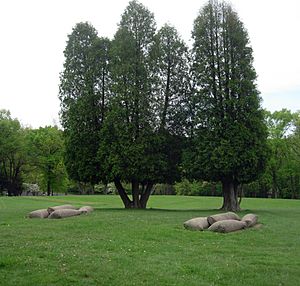Battle of Bushy Run facts for kids
Quick facts for kids Battle of Bushy Run |
|||||||
|---|---|---|---|---|---|---|---|
| Part of Pontiac's Rebellion | |||||||
 Highlanders charge at Bushy Run |
|||||||
|
|||||||
| Belligerents | |||||||
| Ohio Country natives | Great Britain | ||||||
| Commanders and leaders | |||||||
| Guyasuta Keekyuscung † |
Henry Bouquet | ||||||
| Strength | |||||||
| 110–500 | 500 | ||||||
| Casualties and losses | |||||||
| 20–60 killed |
42nd Highlanders: 43 killed 36 wounded |
||||||
The Battle of Bushy Run was an important fight during Pontiac's War in 1763. It happened in western Pennsylvania between British soldiers led by Colonel Henry Bouquet and Native American warriors. These warriors came from the Delaware, Shawnee, Mingo, and Huron tribes. Even though many British soldiers were hurt, they won the battle. This victory helped them reach Fort Pitt, which was under attack.
The Battle Begins
In July 1763, a group of 500 British soldiers left Carlisle, Pennsylvania. Their goal was to help Fort Pitt, which was surrounded by Native American warriors. This group included soldiers from the 42nd, 60th, and 77th Highlander regiments.
Native American scouts watched Colonel Bouquet's soldiers as they marched. On August 5, around 1:00 PM, warriors ambushed the British. This happened about a mile east of Bushy Run Station, at a place called Edge Hill.
First Day of Fighting
The British soldiers fought hard and managed to hold their ground. The fighting continued until after the sun went down. Then, the Native American warriors pulled back.
Colonel Bouquet quickly ordered his men to build a small fort, called a redoubt, on Edge Hill. They placed their injured soldiers and their animals safely inside this protected area.
Second Day and British Victory
The battle continued the next morning. There are a couple of stories about how the British won.
One story says that the Native American warriors attacked again. But British guards, who were just finishing their night duty, surprised them from the side. With this surprise attack and a frontal charge from the main British group, the warriors were outnumbered and ran away.
Another story says that the warriors attacked very strongly. Colonel Bouquet realized the fight was getting very serious. He decided to trick the attackers. He made one part of his battle line look weaker on purpose. When the Native American warriors saw this gap, they rushed forward. But instead, the British soldiers fired their guns and then charged with bayonets. The warriors who survived ran away and could not regroup.
After winning the battle, Colonel Bouquet's soldiers marched to Bushy Run. They needed water badly. Even though most of the fighting happened at Edge Hill, the battle is now known as the Battle of Bushy Run. From there, the British continued their march and successfully helped Fort Pitt.
After the Battle

The Battle of Bushy Run was a tough fight for both sides. About 50 British soldiers lost their lives. This included 29 from the 42nd Highlanders. The Native American tribes also had many casualties, including two important Delaware chiefs.
This British victory was a big relief for the people living on the frontier. It showed that the Native American warriors could be defeated. One newspaper even wrote that "Indians are no more invulnerable than other Men."
Today, the place where the battle happened is a park called Bushy Run Battlefield Park.


